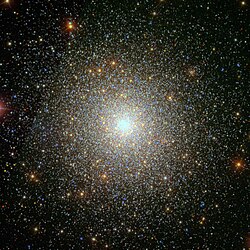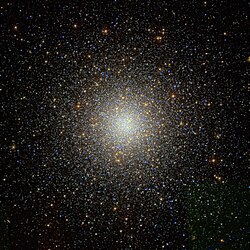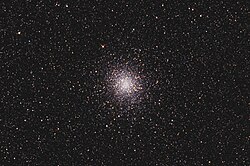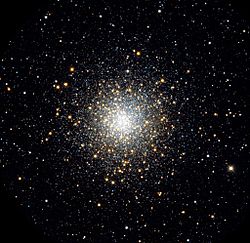Messier 15 HST
Messier 15 is a globular cluster — a spherical conglomeration of old stars that formed together from the same cloud of gas, found in the outer reaches of the Milky Way in a region known as the halo and orbiting the Galactic Centre. This globular lies about 35 000 light-years from the Earth, in the constellation of Pegasus (The Flying Horse).
Messier 15 is one of the densest globulars known, with the vast majority of the cluster’s mass concentrated in the core. Astronomers think that particularly dense globulars, like this one, underwent a process called core collapse, in which gravitational interactions between stars led to many members of the cluster migrating towards the centre.
Messier 15 is also the first globular cluster known to harbour a planetary nebula, and it is still one of only four globulars known to do so. The planetary nebula, called Pease 1, can be seen in this image as a small blue blob to the lower left of the globular’s core.
This picture was put together from images taken with the Wide Field Channel of Hubble's Advanced Camera for Surveys. Images through yellow/orange (F606W, coloured blue) and near-infrared (F814W, coloured red) filters were combined. The total exposure times were 535 s and 615 s respectively and the field of view is 3.4 arcminutes across.Das Material wurde für die NASA vom Space Telescope Science Institute unter dem Vertrag NAS5-26555 oder für die ESA vom Hubble European Space Agency Information Centre erstellt. Urheberrechtserklärung auf hubblesite.org oder 2008 Urheberrechtserklärung auf spacetelescope.org.
Für Material, das von der European Space Agency auf der Website spacetelescope.org seit 2009 erstellt wurde, verwende die Lizenzvorlage {{ESA-Hubble}}.Relevante Bilder
Relevante Artikel
Shapley-Sawyer-KonzentrationsklasseDie Shapley-Sawyer-Konzentrationsklassen bilden ein qualitatives Klassifizierungssystem, mit dem Harlow Shapley und seine Doktorandin Helen Sawyer Hogg ab 1927 Kugelsternhaufen auf fotografischen Aufnahmen nach ihrer scheinbaren Konzentration ordneten. .. weiterlesen























